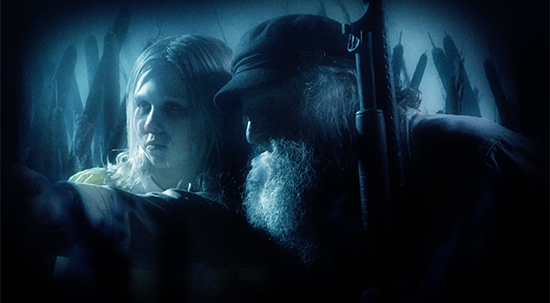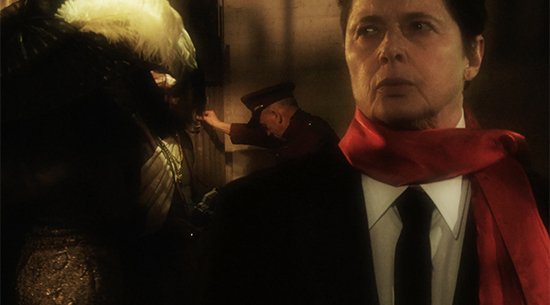Ever since he was a young boy growing up in the frozen tundra of squandered dreams and wasted youth that is Winnipeg, Manitoba, filmmaker Guy Maddin sensed that ghosts were real. His brother Cameron took his own life when he was only 16 years old, and young Guy – then only eight – moved into the late brother’s bedroom. Though the tragedy of the suicide devastated his family – “Grief trickled down into everything,” he says – Guy didn’t endure his loss in the traditional sense. But he did experience the uncanny sensation of merging with Cameron’s essence. Maddin says he metaphysically absorbed the “greatness” of his brother while he simultaneously internalized his brother’s suicidal fascinations. Though he wasn’t particularly depressive in comparison with most teenagers, the lingering memories stored in his dead brother’s room and belongings imbued in Guy an ideation of suicide as a concept. “It was like I became [Cameron] in a very weird way,” he says. Maddin had a strange sense that he and his brother’s ghost had merged. But to Maddin, ghosts aren’t malevolent ghouls that skulk around your home and occasionally touch your shoulder. No, he says, “Ghosts are memories. They visit me in my dreams.”
Maddin’s films exemplify cinema as an art form connected to memories, dreams, and ghosts. They are fragmented dreams of films unrealized, spectres of a cinema-drenched cerebral cortex. The lingering memories of Maddin’s cinematic obsessions: silent films, expressionism, camp, arthouse, horror, the montage film theory of Abel Gance or Sergei Eisenstein, the surrealism of Buñuel or Lynch, the melodrama of Sirk, the bacchanalia of Jack Smith. The power in Maddin’s work is in its referencing of the language of film history that he liquidates into his own idiosyncratic, perverse, humanist, mournful and haunted worldview. It results in a cinema lost in the K-hole, dissociated from time itself and hauntological in nature. Though these films harness the decay and crackle of vintage cinema, they actually seek to fulfill the unbridled modernist promise made by early cinema that was never fully realized. Maddin harnesses a phantasmatic atmosphere that feels like it comes from a bygone era, but is actually located within the temporal dislocation of cerebrality. Writing on Maddin’s 1997 fantasy romance film film <i>Twilight of the Ice Nymphs</i>, cultural critic Steven Shaviro noted that each event in the film is “shadowed by the ghosts of all the things that did not happen. That’s why the film doesn’t take place in the fullness of a living present.” This is cinema as projected subjectivity; a cauldron of memories, ghosts, traumas, obsessions, and psychosexual perversities.
Though his films are diverse in content, themes and narratives, they all are populated by the phantoms of Maddin’s psychology. He – his subjectivity – is a spectral presence in every cinematic image. Some of the movies explore his own memories and personal traumas directly. My Winnipeg, for instance, doubles as a portrait of his icy and detached hometown, while also excavating the psychic traumas inflicted upon him and his siblings by his mother, a woman who used threats of suicide to manipulate and control her children. In other films, Maddin applies his particular worldview and aesthetic flourishes to classic stories, reinventing them as something utterly his own, as he did with Dracula, Pages from a Virgin’s Diary, in which the Bram Stoker classic is reimagined as a melodramatic, camp-soaked ballet, dissolving the boundaries between the highest of high and the lowest of low culture (Maddin loves a high-low mashup sensibility, his personal definition of the sublime is Ed Wood).
Maddin has also, on different occasions, centered his practice around the legacies of specific filmmakers, emphasizing how the films he consumes linger in his psyche like ghosts. He’s, in a sense, resurrected the spirits of filmmakers ranging from Jack Smith to Roberto Rossellini in his work. Last December, Maddin and Evan and Galen were commissioned by BAMPHA in San Francisco to produce a short film, entitled The Rabbit Hunters, celebrating the legacy of Federico Fellini on the occasion of Fellini’s centennial year. Maddin enlisted Isabella Rossellini to portray Fellini, or at least Fellini’s spectral manifestation. Jeff Goldblum was also considered, but Rossellini knew Fellini and his late wife Giulietta Masina personally, and also, “Isabella is just a better Fellini than Jeff Goldblum,” concedes Maddin.
Maddin recently reappraised the late Italian filmmaker, and noted three ways in which his approach to cinema mirrored Fellini’s. Maddin connected the ways in which Fellini used his hometown of Rimini as a setting in his early films, that was similar to the way that he framed his hometown of Winnipeg in his. “Rimini is like the Winnipeg of Italy,” says Maddin. “An eerie place where you waste your youth and dream about going to other places.” His fascination with Fellini was fortified after rewatching Fellini’s lesser known Terence Stamp-starring Edgar Allen Poe adaptation Toby Dammit (which actually comprised the standout section of an anthology of Poe adaptations entitled Spirits of the Dead (1968), that also featured sections directed by Louis Malle and Roger Vadim) that stripped much of the lighthearted “sprezzatura” feel (a specifically Italian sense of carelessness) of Fellini’s better known works, and allowed Maddin to locate an essential sinister darkness at the core of Fellini’s filmography – a darkness similar to that which drives Maddin’s own creativity.

But the true motivator of The Rabbit Hunters and the genuine connection between Maddin and Fellini is, no surprise here, that both filmmakers are motivated by dreams and fantasies. Maddin learned from Rossellini that Fellini was a brutally cruel philanderer who mistreated his wife Masina in his waking life. But in his dreams, which he painstakingly documented in a journal (published as a text in Federico Fellini The Book of Dreams), Fellini visualized his wife constantly. “In dreams, he worries about Giulietta all the time,” says Maddin. “Her health, and her worries. There must have been something between them that kept them together all those years.”
Initially, Maddin, Evan and Galen wanted to recreate dreams directly from Fellini’s journals, but those journals were copyrighted. Unable to afford the rights to recreate Fellini’s actual dreams, Maddin and his collaborators decided to use their own dreams and curate them according to the dreams that Fellini documented. Luckily, Maddin realized that his dreams often overlapped with the ones experienced by Fellini. “Missing flights, missing film premieres, dreams about wives,” muses Maddin. “Fellini and I have commonalities in our anxiety dreams.”
The Rabbit Hunters opens with the provocative line: “Last night I dreamt I was still alive,” delivered by lead star Rossellini as the disembodied voice of Fellini’s spirit. Maddin uses his own interiority to re-construct a dreamspace that Fellini would feel at home in. The brief nine-minute film operates as a metaphysical resurrection of Fellini’s dream projection of himself, with Fellini journeying through the transcendental projection of his own dreams as filtered through Maddin’s own hallucinatory exploration of Fellini’s journals. “We decided to let the tone be our own,” says Maddin. “Fellini had anxiety but it was balanced. We’re Icelandic, so we don’t have that. We brood until noon.” The approach allows Maddin to locate an oft-overlooked aspect of who Fellini was as an artist and a man. Removed from this vision of Fellini are the over-sexualized and carefree women, and in their place is Fellini’s guilt and melancholy.
The Rabbit Hunters opens with Fellini’s ghost lost in the cosmos (not played by Rossellini, instead projected via stock image) before awakening, and into the new reality of Maddin’s Fellini-influenced labyrinthic apparition. After missing the premiere of his own movie, Rossellini as Fellini exits the theater and finds himself against a gorgeous, blue-lit marsh, and finds young boys playing the same game he played as a child. Surreal sexual scenarios play out between Fellini and a teacher, portrayed here by a drag queen. The titular rabbit hunter is a vaguely malevolent presence, forcing Fellini to miss the flight that was carrying Giulietta, resulting in Fellini’s brief reincarnation as Maddin’s astral projection to be cut short, fading back into nonexistence.
Maddin, being an artist primarily concerned with the abstract material of dreams, uses The Rabbit Hunters as an opportunity to hybridize his dreamspace with that of Fellini. And of course, for Maddin, dreams are a space where the ghosts that haunt him present themselves and speak to him. Maddin’s primary purpose as an artist seems to be the expatriations of his ghosts; if he can show us these ghosts, maybe they will go away. Sometimes these ghosts are his personal memories. His demons and traumas. His psychosexual anxieties. In the case of a project like The Rabbit Hunters, they are the ghosts of his cinematic obsessions. It’s over-simplified to state that Maddin’s films are simply dream-like. The films are, at times, positively wakeful and alive. It’s more accurate to say that Maddin’s films are the exhibitions of his ghosts. And ghosts, like Maddin’s films, are fragmented, and disorient the senses. They are not in the past, they are ever present and ever absent, temporally displaced and immaterial.
“I’m pretty haunted,” says Maddin. “I just am.”


